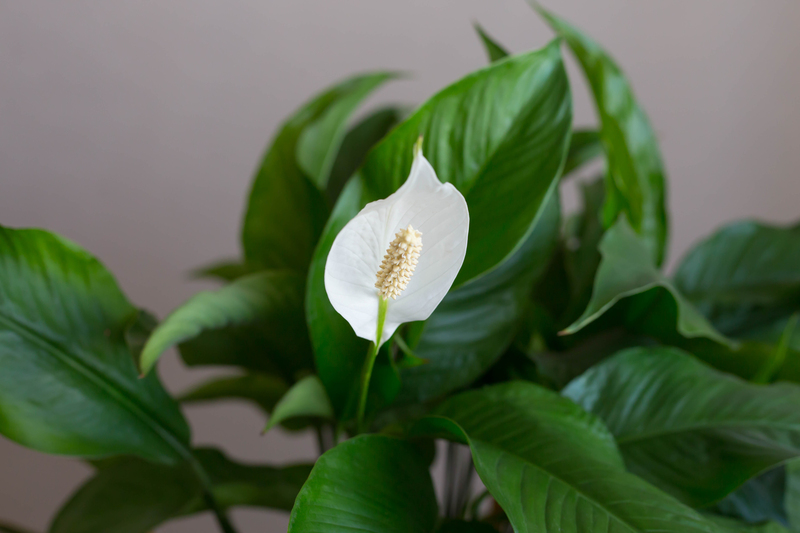Maximize Your Space with Vertical Gardening Techniques
Posted on 21/06/2025
Maximize Your Space with Vertical Gardening Techniques
Do you love gardening but lack enough space? Don't worry! With the help of vertical gardening techniques, you can transform even the smallest balcony, patio, or indoor corner into a lush green paradise. Learn how to harness the power of vertical gardens to maximize your space, grow more plants, and enhance the visual appeal of your environment!
What is Vertical Gardening?
Vertical gardening refers to the practice of growing plants upward instead of outwards, utilizing walls, trellises, hanging systems, and other creative structures. Rather than spreading across the ground, plants are arranged in vertical layers, letting you get the most out of every inch.
This space-saving gardening technique is perfect for urban dwellers, apartment owners, and anyone looking to maximize garden space creatively. Not only is it aesthetically pleasing, but it also improves air quality, insulates buildings, and can even provide fresh produce.

Benefits of Vertical Gardening: Why Go Upwards?
- Space Optimization: Perfect for small yards, balconies, and urban environments.
- Increased Yield: Grow more in limited space by stacking plants vertically.
- Enhanced Aesthetics: Turn dull walls and fences into living works of art.
- Better Air Quality: More greenery means improved oxygen levels and reduced pollutants.
- Pest and Disease Management: Elevating plants can reduce ground pests and diseases.
- Easy Maintenance: Less bending and weeding compared to traditional ground gardens.
Popular Vertical Gardening Techniques and Systems
Explore these effective vertical garden ideas to find the perfect method for your available space and desired plants:
1. Wall Planters and Living Walls
Wall planters or vertical wall gardens are among the most popular vertical gardening systems. They use modular panels, pockets, or pots mounted directly onto a wall or freestanding frame.
- Felt pocket systems: Perfect for herbs, ferns, and small flowers. Water flows down naturally, keeping roots moist.
- Modular panels: Come in various materials and are suitable for both indoors and outdoors.
- DIY pallet gardens: Old shipping pallets can be refashioned into rustic vertical planters. Just add landscape fabric to hold the soil, load up with plants, and lean against a wall.
2. Trellis and Lattice Structures
Trellises and lattices provide sturdy support for climbing vegetables, flowers, and vines. This method is ideal for:
- Cucumbers, beans, peas, and tomatoes
- Climbing roses, clematis, and morning glories
3. Vertical Towers and Stacking Planters
Tower systems are freestanding vertical structures with stacking tiers for planting. These modular planters allow you to grow herbs, strawberries, succulents, and even leaf lettuce.
- Great for balconies, patios, or sunny indoor corners.
- Efficient drip irrigation systems can be incorporated for easy watering.
4. Hanging Gardens and Suspended Containers
Use hanging baskets, pots, or upcycled containers suspended from railings, ceilings, or horizontal beams. Hanging gardens can be both decorative and highly productive.
- Grow trailing plants, strawberries, cherry tomatoes, or foliage plants.
- Fantastic for renters or anyone wanting a temporary garden setup.
5. Gutter Gardens
Repurpose old rain gutters by mounting them horizontally onto fences, sheds, or walls.
- Ideal for shallow-rooted plants like lettuce, spinach, and herbs.
- Arrange in staggered rows for a beautiful cascading effect.
Choosing the Right Plants for Vertical Gardening
Not all plants will thrive in a vertical garden. Choosing varieties that suit your system and light conditions is crucial for a lush, productive space.
- Leafy greens: Lettuce, spinach, arugula, bok choy, and Swiss chard do well in small containers and wall systems.
- Herbs: Basil, mint, thyme, oregano, chives, coriander, and parsley are perfect for pockets, gutters, or towers.
- Edible flowers: Nasturtium, viola, calendula, and pansies bring color and edible blooms.
- Vines & climbers: Tomatoes, pole beans, peas, cucumbers, passion fruit, and morning glory are ideal for trellises and lattices.
- Succulents and cacti: These require little soil and water, making them excellent choices for indoor vertical displays or dry sunny walls.
- Small fruiting plants: Strawberries, dwarf peppers, and small chilies can be grown in pocket planters or towers.
- Ornamentals: Ferns, mosses, philodendrons, and pothos are beautiful for indoor green walls.
How to Start Your Own Vertical Garden
1. Assess Your Space
Begin by evaluating your available area. Is it a sunny wall, a balcony railing, or a fence? Consider light exposure, wind, and access to water.
2. Choose a System
Select a vertical gardening technique that suits your space and gardening goals. DIY options like recycled pallets are budget-friendly, while modular wall planters offer a sleek, finished look.
3. Gather Materials
- Pots, panels, or containers
- Quality soil or planting mix (lightweight and nutrient-rich)
- Plants or seeds suitable for your local climate
- Fasteners, brackets, drip irrigation supplies (as needed)
4. Plant and Install
Plant your chosen varieties according to light needs and growth habits. For wall gardens, put trailing or bushy plants lower and upright growers higher.
5. Water & Maintain
Vertical gardens dry out quickly. Set up a drip or self-watering system, or water daily by hand, especially in hot weather.
- Feed with diluted liquid fertilizer every two weeks during the growing season.
- Prune and harvest regularly to promote new growth.
- Watch for pests like aphids or spider mites, especially indoors.
Innovative and Creative Vertical Garden Ideas
Looking for inspiration? Try these unique vertical gardening ideas to instantly refresh your space:
- Repurposed Shoe Organizers: Fill the pockets with soil and plant herbs, flowers, or lettuce. Hang over fences, doors, or balconies.
- Upcycled Wooden Ladders: Lean an old ladder against a wall and arrange small potted plants on each rung.
- Vintage Picture Frames: Create living art by mounting moss, succulents, and colorful foliage inside ornate frames.
- Rain Chain Planters: Hang small pots or cups from an outdoor rain chain for a whimsical cascading effect.
- Stacked Crates or Baskets: Pile wooden crates or wicker baskets in a pyramid, filling each with soil and vibrant annuals.
Indoor Vertical Gardening: Bringing Greenery Inside
Vertical gardening is not just for the outdoors. Indoor green walls, vertical hydroponic systems, and hanging planters let you cultivate fresh food and stunning foliage all year. Place vertical gardens in well-lit spaces such as:
- Living rooms or bedrooms for air-purifying plants
- Kitchens for fresh herbs at arm's reach
- Bathrooms for moisture-loving ferns and mosses
- Office spaces to enhance mood and productivity
Vertical Gardening Maintenance Tips
Regular maintenance is essential to keep your vertical garden lush and healthy. Here's how to make your vertical oasis thrive:
- Water wisely: Use a drip system when possible. Ensure even moisture and avoid letting the lower plants dry out, as they often receive less water.
- Never overwater: Good drainage prevents root rot. Check that panels or pockets don't trap excess water.
- Fertilize regularly: Vertical systems can be limited in nutrients. Apply a balanced, liquid feed every 2-4 weeks.
- Prune and Replace: Remove dead foliage, prune overgrown plants, and replace any that don't thrive.
- Inspect for Pests: Check leaves and roots for insects or mold and treat promptly.
- Monitor Sunlight: Move or rotate planters seasonally if necessary to ensure adequate light exposure.
Mistakes to Avoid in Vertical Gardening
- Overcrowding: Give each plant proper space to prevent disease and ensure adequate growth.
- Inadequate water: Check soil moisture frequently, especially on the upper levels of your garden.
- Poor anchoring: Ensure your structures are securely attached to prevent accidents from wind or weight.
- Ignoring light requirements: Select plants based on their sun or shade preference for your location.
- Neglecting maintenance: Vertical gardens need regular care to keep them looking their best.

Frequently Asked Questions on Vertical Gardening Techniques
How much does a vertical garden cost?
Costs can range from inexpensive DIY projects using recycled materials to several hundred dollars for pre-made modular systems. Factor in irrigation, quality soil, and plant costs.
Which vertical gardening system is easiest for beginners?
Pocket planters and shoe organizers are very beginner-friendly. Just add soil and start planting!
How often do you water a vertical garden?
Watering frequency depends on plant choice, weather, and system depth. Generally, vertical gardens dry faster than ground beds and may need watering daily during hot periods.
Are vertical gardens suitable for vegetables?
Absolutely! Many vegetables, such as lettuce, spinach, tomatoes, peas, beans, and peppers, adapt well to vertical growing.
Conclusion: Unlock the Possibilities of Vertical Gardening
Vertical gardening techniques offer a smart, beautiful, and eco-friendly way to maximize your space--no matter how small it is. By growing upward rather than outward, you can cultivate a flourishing garden on balconies, patios, indoor walls, or even tiny urban plots.
Ready to maximize your space with a vertical garden? Start small with a DIY wall planter or go bold with a living green wall--and enjoy the year-round rewards of vertical gardening success!
Looking for more vertical garden ideas? Subscribe for updates, tips, and inspiration to help your vertical oasis thrive!

